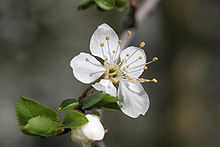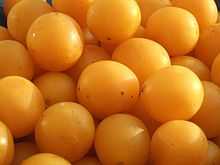Mirabelle plum
| Mirabelle plum | |
|---|---|
 | |
| Blossom of Mirabelle plum in detail | |
| Scientific classification | |
| Kingdom: | Plantae |
| (unranked): | Angiosperms |
| (unranked): | Eudicots |
| (unranked): | Rosids |
| Order: | Rosales |
| Family: | Rosaceae |
| Genus: | Prunus |
| Subgenus: | Prunus |
| Section: | Prunus |
| Species: | P. domestica |
| Subspecies: | P. domestica subsp. syriaca |
| Trinomial name | |
| Prunus domestica subsp. syriaca | |
The mirabelle plum, also known as the mirabelle prune (Prunus domestica subsp. syriaca), is the edible drupaceous fruit of the mirabelle prune tree, a cultivar of the plum tree of the genus Prunus. It is believed that the plum was cultivated from a wild fruit grown in Asia Minor.
Description

The mirabelle is identified by its small, oval shape, smooth-textured flesh, and especially by its dark yellow colour which becomes flecked in appearance. They are known for being sweet and full of flavour. The fruit is primarily used in jams and pies, and its juice is commonly fermented for wine or distilled into plum brandy. Ninety percent of mirabelle plums grown commercially are made into either jam (70%) or eau-de-vie (20%). The plums are also excellent when eaten fresh.
In Romania, mirabelles are usually eaten before they are ripe.[citation needed] This is when they are sour and hard, but they are still enjoyed all over the country. It is arguable whether or not the fruit is better when ripe.
The mirabelle reaches maturity and is harvested from July to mid-September (Northern Hemisphere). The traditional method of shaking the trees is now mechanized, but the principle remains the same: The ripe fruits are shaken loose and collected in a net under the tree.
Mirabelle de Lorraine

The mirabelle is a specialty of the French region of Lorraine, which has an ideal climate and soil composition for the cultivation of this fruit. This region produces 15,000 tons of mirabelle prunes annually, which constitutes 80% of global commercial production.
There are two main cultivars grown for fruit production, derived from cherry plums grown in Nancy and Metz. The Metz type is smaller, less hard, and less sweet, and has no small red spots on the skin. It is very good for jam, while the Nancy type is better as fresh fruit as it is sweeter.
Since 1996 the mirabelle de Lorraine has been recognized and promoted by the EU as a high-quality regional product, with a Protected Geographical Indication (PGI). This label guarantees a minimum fruit size (22mm) and sugar content, and can only be used in a specific geographical zone of production.
The city of Metz dedicates two weeks to the Mirabelle plum during the popular Mirabelle Festival held in August. During the festival, in addition to open markets selling fresh prunes, mirabelle tarts, and mirabelle liquor, there is live music, fireworks, parties, art exhibits, a parade with floral floats and competition, and the crowning of the Mirabelle Queen and a gala of celebration.
In Spain it grows in Galicia, in O Rosal, a valley in the south of the province of Pontevedra in which was introduced in the mid-twentieth century by Xosé Sánchez García and where it has acclimated to perfection. In Galicia it is consumed fresh. But they also manufacture and commercialize preserves and liqueurs. It is also naturalized in the Ebro Valley in parts of Zaragoza, Teruel, Lleida and Tarragona, and can be found near rivers, irrigation canals and road ditches. In Aragon mirabelle plums are called cascasbeles.
In England, mirabellas grow both wild and cultivated in Essex, and there are yellow, orange and red varieties in Mayland, Essex. The Metz variety grows wild in Suffolk at Leathes' Ham, near Oulton Broad.
They are likewise found in the Czech Republic both wild and cultivated, often at roadsides.
References
| Wikimedia Commons has media related to Mirabelle plum. |
- European Garden Flora; vol. IV; 1995.